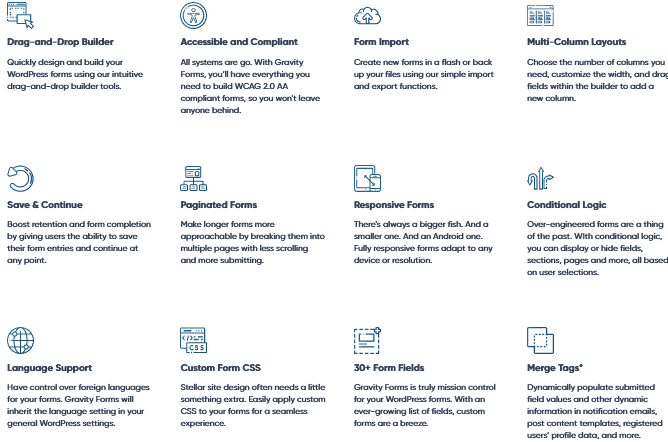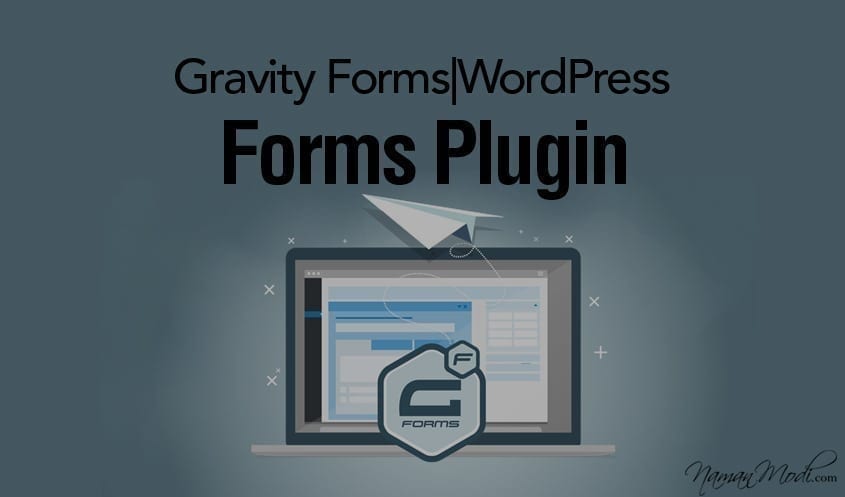Gravity Forms has long been used and respected by some of the biggest brands in the industry and is regarded as the most powerful form-building plugin for WordPress. Gravity forms have lately experienced increased competition which begs the question – is it still the people’s form-building plugin or has it lost its touch. This article will help us answer this question by exploring the plugin’s latest version and how it has evolved to stay on top. Read through for more information.
Table of Contents
Gravity Forms Features

Don’t be fooled by Gravity Forms’ simplicity and ease of use. It is an advanced form of WordPress and its features go beyond your regular forms plugin. Gravity Forms allows you to create almost any type of form, including user surveys, polls, file upload forms, support requests, online orders, quizzes, and questionnaires. Gravity Forms accepts fully formatted WordPress forms submissions due to its rich editor field.
Its configuration settings give its users great control over how users interact with your forms and how form entries are handled. It has options to show who receives the form entry notifications and in what format. The WordPress forms plugin can also set the availability of WordPress contact forms according to date, user role, or the number of entries received, and much more. It has a conditional logic feature making it one of the most powerful Word Press form solutions.
Based on the values entered in the previous fields, conditional logic is used to determine which form fields are displayed to a user. With conditional logic, you can also allow advanced routing of form entries, ensuring messages are delivered to the right department or team member. This will depend on the contents of the form information. The plugin’s functionalities are incredible providing a lot of room to customize. Here are some of the Gravity Forms best features.
- An intuitive drag-and-drop form builder interface
- Thirty-three form fields
- You can create multi-page forms with save-progress buttons
- Allows control form availability by date or number of entries
- Has the ability to route entries to specific email addresses based on form contents
- You can control which form fields are displayed and where form entries are sent using conditional logic
- Can accept WordPress post submissions through front-end WYSIWYG-enabled forms
- Allows the creation of WordPress website user account registration forms
- You can optimize your forms for mobile use
- Has an invisible anti-spam honeypot used to reduce form spam
- Allows selection of official and third-party free and commercial add-ons.
- Has support for creating multiple form entry notifications
Now let’s dive in and explore these features in a detailed manner.
Gravity Forms Field Types
There are four categories of Gravity Forms fields: standard, advanced, post, and pricing. The WordPress form builder can create any type of form; whether you want to create a simple contact form, build quote request forms for your service, or start accepting orders through your website, the various selections of fields gives you no trouble building the forms you need. The post fields enable you to design a form that will use to submit form data to create post drafts on your WordPress website and gravity forms login.
Gravity Forms Field Settings
There are several ways to customize and configure all of Gravity Forms fields. You can decide whether it’s a required field depending on which type of field you’re working with. You can also choose to use placeholder text, the size of the field, the visibility of the field, or whether the field is pre-populated with several different types of data. Apart from helping you build the advanced forms you need, Gravity Forms also has an intuitive user interface and gravity forms documentation.
See More: WordPress Form Plugin | Captain Form
Control of Form Availability
Gravity Forms allows you to limit the number of entries your forms can accept, or limit form availability to a specific date range. You can define the availability of the form and add useful messages to inform your users of the form’s status, using the restriction settings. You can also create free contact forms.
Form Entry Notifications and Delivery
This is made possible through the use of conditional logic, which plays a great role in the functionality of Gravity Forms. One way to use it is to direct form entries to specific email addresses based on the contents of the form. This is done by adding a dropdown list to your form, allowing the user to categorize the content of their message. This selection is used to route the form entry to the suitable section in your organization.
Gravity Forms Add-ons
For those who want to integrate their forms with their email marketing service, Gravity Forms provides basic add-ons for business and developer license holders to achieve this. The plugin supports AWeber, Campaign Monitor, GetResponse, MailChimp, and others. This service is offered on an upgrade of $99 for a business license for those who want to grow your newsletter subscribers. It is important to find out which options are available for your setup, since some integration with specific email marketing services, such as ConvertKit, are provided via free plugins. You can access all these through the gravity forms license key.
Advanced Add-ons
Gravity Forms has advanced add-ons that cover integrations with other types of services, such as Slack, Fresh Books, Dropbox, Help Scout, PayPal, and other third-party services. An advanced add-on is also provided to allow users to register on your WordPress website through your custom forms. Integration is one Gravity Forms strongholds. So for a WordPress forms plugin that offers a specific type of connectivity, ensure you explore the list of available add-ons. The $39 Personal license and the core features of Gravity Forms may be the right pricing option for you if you aren’t planning to integrate your forms with any third-party services.
Gravity Forms Third-Party Add-ons
Apart from the official Gravity Forms add-ons, several third-party extensions are also available. A good example is Gravity Perks which allows you to find code snippets that add enhancements to the plugin. Another interesting add-on is the Gravity View for enhancing the plugin’s ability to publish form entries on your WordPress website.
Gravity Forms User Experience
Gravity Forms has a wonderful and outstanding user experience from getting started, creating forms, to customization. All these processes are a breeze. It makes you wonder how a feature-filled plugin can manage all its functionality seamlessly.
Gravity Forms Pricing
Gravity Forms is a premium WordPress forms plugin, and is available on three pricing plans:
- Ø Personal license: $39 (use on one site and no access to add-ons).
- Ø Business license: $99 (use on three sites and access to basic add-ons).
- Ø Developer license: $199 (use on unlimited sites and access to basic and advanced add-ons).
Checkout quick video review on Gravity Forms
Source: Ferdy Korpershoek
Conclusion
My final thoughts about Gravity Forms is that it’s a promising forms plugin that has no limit in form creation and can really deliver, unlike other forms plugin. Gravity forms support is helpful and can be accessed through email and direct calls. It has detailed settings and options giving you full control over how your forms function, choosing higher-priced plans, gives you access to add-ons which provide plenty of scope for integration with third-party products and services. Gravity Forms is very easy to use. The drag-and-drop form builder makes creating forms straightforward, while settings and options are intuitively presented. Look for other Gravity reviews for more information.
Here are a few more topics that you shouldn’t miss:
4 Best E-commerce Platforms for Online Business
ProWritingAid: The Best Editing Tool
Tops Reasons Why Email Marketing Is Indispensable
Like this post? Don’t forget to share






